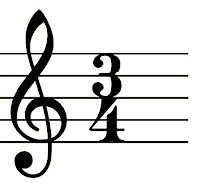Time Signatures; let’s get to know them better. In the last
entry, we tacked a portion of the piano sheet music; the piano notes. Now in
this entry let’s discuss more this time about time signatures.
Time signatures play a vital role in proper piano playing. It
helps pianists count the music. Count the music? Yes, it’s possible to count
the music. Music counting defines the speed and the music rhythm that should
be played in a certain piano sheet music. This is the responsibility of Time
Signatures.
Time Signatures are like identifiers. It tells what a measure as to both the
number of beats and the value of each beat because we divide music into beats.
Confusing? Not at all! Just think that time signatures are the pulse or the
beat if the music.
So where are they on the piano
sheet music? You can read and see them at the beginning of
the piano sheet music just after the clefs. They’re signified by numbers or
some symbols depending on the time signatures.
The top number represents how many beats is in a
measure while the bottom number represents what type of note gets one beat.
You can see a lot of variations of time signatures. All of
them have different counts. One of the most common time signatures are the 4/4
count and the 3/4 count. Most piano music and many kinds of music use either of
the two as their music rhythm.
The 4/4 time signature is the most popular and most used time signature that you can here in almost
every genre of music. It means there are four quarter notes (or any combination
of notes that equals four quarter notes) in every measure. Most of the time it
is represented by a small bolded letter C which means common time.
The 3/4 time signature is another common time signature that you can see in many piano sheet music. It means that there are three quarter notes
(or any combination of notes that equals three quarter notes) in every measure.
A piece in six eight (6/8) might have six beats in every
measure, with an eighth note getting a beat. This is also a very often-used time
signature. To count the beat try this: 1, 2, 3, 4, 5, 6, 1, 2, 3, 4, 5, 6,
etc.
There are also other variations of time signatures. In most
cases, they are rarely used or too traditional like a 7/4 count, 8/4 count and
even a 5/4 count.
Time signatures are very important in terms of knowing the
beat of the music. It will help you understand it more and put more emotions in
it. Learn how to play the piano better
and easier.









No comments:
Post a Comment